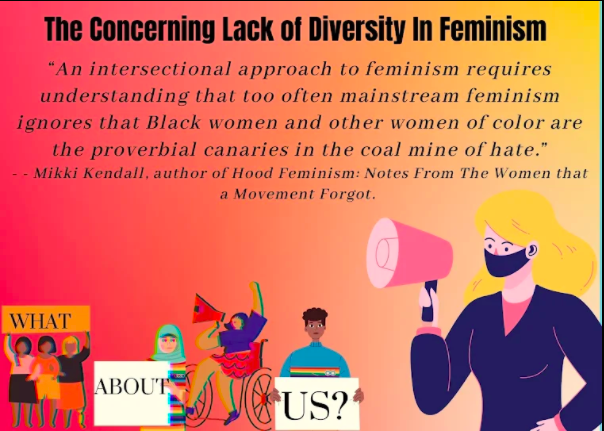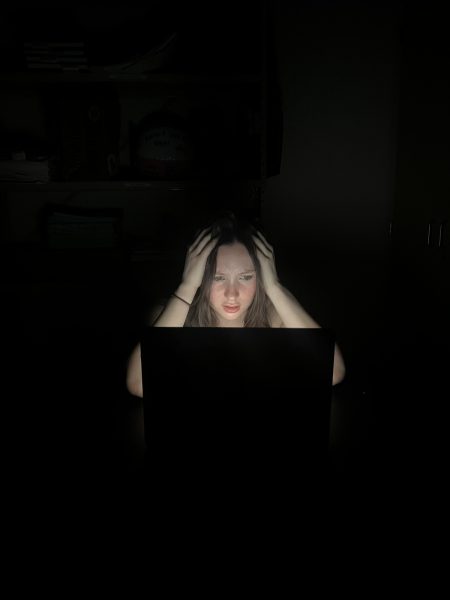Feminism and its concerning lack of diversity
The feminism movement has a very white nature and lack of inclusion or emphasis of marginalized groups and their issues
Feminism: A movement that began in the early nineteenth and twentieth centuries strives for equality between men and women. For years, a campaign built on freedom and equality with very virtuous intentions has been betraying many.
The people being betrayed by this movement include women of color, trans women, nonbinary people, disabled individuals, LGBTQ+, and many more have been and continue to be erased from the narrative of equality regarding feminism. It is something that they not only deserve to be a part of but need to be included in. If marginalized communities are not included in these movements and discussions, feminism and society will never truly be equitable.
The concept of white feminism refers to the version of the movement that focuses solely on white women’s issues rather than focusing on women as a whole. Additionally, white feminism disregards white privilege and does not acknowledge self-awareness regarding privilege. It ignores explicitly systematic oppression that benefits white women yet hurts people of color and other marginalized communities.
This is not a new concept; the feminist movement has been harming women of color ever since suffrage. This is not discussed in history class or modern-day discussions, but we need to be precise. When women were fighting for the right to vote, they were only fighting for white women. When women finally were given the right to vote, not all women had the right to vote—only white women.
White women were given the right to vote in 1920 with the 19th amendment that supposedly allowed “all women” the right to vote. Black women were not permitted the right to vote until 1965 with the passing of the Voting Rights Act. Latinx were not allowed to vote until after 1965, when an extension to the Voting Rights Act was implemented. Native American women were not even considered American citizens in 1920, and even in 1962, there were still restrictions placed in states to prevent them from voting. The same goes for Asian women who immigrated; they were not given the right to vote until 1952 with the Immigration and Nationality Act of 1952.
So many issues that should be addressed in modern-day feminist environments are not. An unfortunate example of this is violence against women of color being so prominent yet rarely discussed. According to the National Crime Information Center (NCIC), about 2,700 cases of murder against Alaska Natives Indigenous women have been reported in the United States. According to the Department of Justice, the rate of Native Americans being murdered is ten times the national average.
Additionally, Queer issues are often disregarded, and the binary is enforced as trans women and trans individuals are hardly ever included. Hate crimes against transgender individuals are heartbreakingly common and, unfortunately, have increased in recent years. According to the Human Rights Campaign, hate crimes against trans individuals reached an all-time high. About 50 trans and gender non-conforming individuals were victims of hate crimes in 2021.
Collectively, feminists and the general movement should learn to embrace the concept of intersectionality. Intersectional feminism is a term defined as “a prism for seeing how various forms of inequality often operate together and exacerbate each other,” by the founder of the term, Kimberlé Crenshaw.
Intersectional feminism, unlike White feminism, actually encourages discussions of privilege and allows for self-awareness. If the feminist movement were to embrace this concept of feminism, then the narratives would focus on cis and straight white women and be much more inclusive. The first step in accomplishing progress is to discuss it. Currently, in feminist circles, it is unfortunately common for marginalized communities to bring up their experiences and be ignored with statements such as, “but we also face oppression” from those who are quite privileged.
Another way to improve this dangerous lack of diversity is to educate oneself. Educating yourself on these issues that affect marginalized communities that you are not a part of is extremely important in conducting change. It is not the job of any marginalized community to educate people about their issues, as they have for so long. Therefore, education and research regarding issues you are not aware of are imperative to having meaningful discussions. For example, several books have been written by women of color about White Feminism and how it has negatively affected them personally and their communities. You can also educate yourself on issues previously mentioned, such as the unspoken dangers that Indigenous Women face, hate crimes amongst trans individuals, how abortion disproportionately affects individuals of color and transgender, etc. There are so many issues, including immigration and economic welfare, that also need to be addressed in feminist environments that should be researched and discussed to genuinely accomplish change and diversity of all kinds.
Lastly, listening is critical. If a woman of color discusses racism and white privilege, don’t downplay their experiences or get defensive. Those types of reactions are not helpful and are highly discouraging. Listening to the stories and experiences of communities that you are not familiar with is extremely important. It allows for self-awareness regarding privilege that you may have been aware that you had or to forms of oppression that you may have thought existed due to that privilege. When people of color, LGBTQIA+, disabled, etc., are talking about their oppression and experiences, it is crucial that you listen. Listening is the best way to show that you care and genuinely want to improve and learn.
Feminism is a movement that can be so much more than an un-diverse movement. It can uplift and feature the perspective of so many different people. Women will never truly be equal until all women are equal. The dangers of white feminism persist and will affect many until it is dismantled.
Books about the subject matter include Hood Feminism: Notes from the Women that a Movement Forgot by Mikki Kendall, White Feminism by Koa Beck, Me, Not You: The Trouble with Mainstream Feminism by Alison Phipps, etc.
Some wonderful feminists to follow include:
Schuyler Bailar, a trans man who highlights and discusses trans issues;
Sydney Freeland, a Navajo and transgender filmmaker who strives to discuss the issues of trans and indigenous individuals;
Issa Rae is an actress, writer, and producer who creates content such as Insecure and Awkward Black Girl featuring Black women in a non-stereotypical, realistic, and well-written way.
What did you think about this story? Do you have any suggestions for improvements or other articles that you would like to see? Please use the contact form to communicate with us! (Keep all information school-appropriate)
https://docs.google.com/forms/d/e/1FAIpQLSeRYRWwLLzvs2rqwHSGdr-DQRvxhUSx9UcaXypXxnvVuCqwyA/viewform













